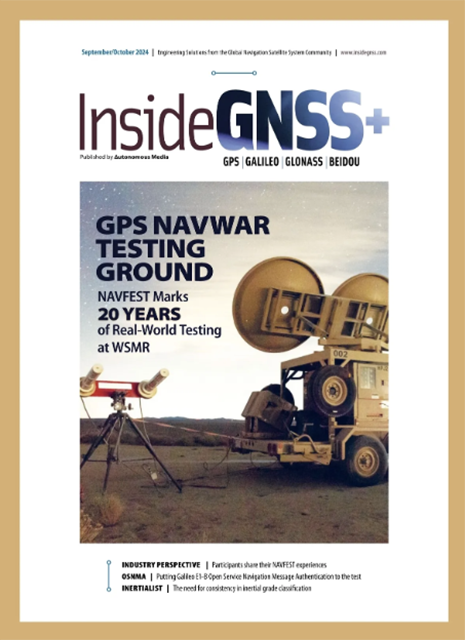Reducing the number of GPS receivers installed or carried while tapping multiple PNT sources.
Prototyping and beta testing are techniques closely associated with Silicon Valley, the innovation engine admired around the world and, in particular, inside the Pentagon. Simply introducing a new idea has been known to take years in these halls; witness the long introductory saga of GPS itself in the 1970s.
The Department of Defense, working to unshackle itself from ponderous past practices, has already had success by updating contracting options to better interact with entrepreneurial companies. Now it’s absorbing some of their style of development, especially when it comes to assured positioning, navigation and timing (A-PNT).
Making sure that PNT capabilities are not lost due to jamming, spoofing or other disruptions is one of DOD’s highest overall priorities. For the Army in particular it’s an enabling capability for its top six modernization priorities, according to the newly released 2019 Army Modernization Strategy: Investing in the Future.
The Army’s Futures Command (AFC) is changing the philosophy underlying the way the service develops products for the warfighter, said Col. Nick Kioutas, the Army’s PNT project manager. Its new philosophy, called development operations, “is get some capability out now.”
AFC has a two-pronged approach:
• have users test prototypes early in the development phase to both see if they like a device enough to really use it and to get their suggestions for improvements and
• speed up the acquisition process through iteration instead of requirements analysis.
“Instead of maybe writing the perfect, supposedly perfect, requirement that takes, say, five years to perfect,” said Kioutas, “and then giving it to the acquisition community to develop the capability and field that capability over a long period of time—by which time the technology is already getting obsolete and maybe the soldiers didn’t even really like it because you really never got their feedback—the concept is to get something into their hands.”
MAPS and DAPS
Army PNT uses this approach to support development of a new PNT capability to reduce the weight, power requirements and collective space needed for GPS receivers and antennas. They also want to add enough different sources and types of PNT to these units to ensure that the capability is available to the warfighter even in contested or denied areas.
To get their arms around the problem and move forward, the PNT team broke the challenge into pieces, said Willie Nelson, director of the Army’s A-PNT Cross-Functional Team. They are now developing the Mounted Assured PNT System or MAPS, and the Dismounted Assured PNT System or DAPS.
“We struggled for years to get a requirement approved for PNT, because it’s a challenge,” said Nelson, “but what we did is broke that down into what we call bite-sized or fieldable pieces: a mounted application and a dismounted application.”
MAPS aims to address the size, weight and power issues (or SWAP) by placing fewer receivers and antennas on a vehicle, instead distributing PNT data from a central unit to all the devices that need it.
“You might have three or four GPS (devices) inside one vehicle,” Kioutas, explained. “If you wanted to provide an anti-jam, you either have to provide, say four in that case, four anti-jam antennas, which is untenable, or you’d have to have one anti-jam antenna and distribute PNT capability across all those mission equipments. That’s kind of what we’re doing.”
That approach went from requirements to prototyping to fielding in about 18 months, Nelson said. The Army distributed 62 of its Gen 1 (first generation) MAPS units to the 2nd Cavalry Regiment in Germany in September. The units were installed on the regiment’s Stryker armored fighting vehicles for evaluation.
“The plan is to do another 339 systems next year,” Kioutas told Inside GNSS. There will probably be more Gen 1 systems fielded before the Gen 2 (second generation) units are ready, he said, adding that the Army may buy upwards of 8,000 Gen 2 systems.
One firm, GPS Source, participated in the Gen 1 contract. That firm has been acquired by General Dynamics. GPS Source was also competing for the Gen 2 MAPS contract along with L3 and Collins Aerospace. Collins was up-selected in October. That sets up an interesting dynamic, as the feedback on MAPS Gen 1 devices will be used to inform MAPS Gen 2.
Feedback
The Army brought all the MAPS vendors to the annual PNT Assessment Exercise (PNTAX), held at White Sands Missile Range, New Mexico for the first time this summer. Soldiers tried out the Gen 1 systems. Their feedback is being shared with Collins so the company can incorporate some of the suggested changes and upgrades into Gen 2.
“Additionally,” said Kioutas, “we have a field service rep in Germany that is actually kind of a really good blend of your traditional logistician, but also a data analyst. He’s collecting all the right data to inform us. What was the mean time between failures? Was that acceptable? How did the soldiers interact with the system? Was the maintenance an issue? It’s hard because we do have a compressed timeline, but those are the kinds of thing that we’re all rolling into the Gen 2 capability and certainly the Gen 3.”
Eventually the Army will decide whether to stick with the Gen 1 MAPS units by GPS Source or go with Collins’ Gen 2 system.
“We’ll assess against the Gen 1,” Kioutas said, “and see does the Gen 2 provide additional capability for the soldiers and should we field that system instead of staying with the Gen 1. So a kind of an upgrade methodology.”
A key factor in assessing best value is how soldiers like the units. “It’s no longer just an economic and capability assessment, but it really has a lot to do with what did the soldiers like. What recommendations did they have for improvement? Can we integrate those improvements in the near term? And then how do we, if not, spin those upgrades out to the next generation?”
MAPS Gen 3 is really predecisional now, Kioutas said, but development will likely begin in the 2024 timeframe. The Army will try to make upgrades and changes easier by developing a modular, open-system architecture, especially when it comes to MAPS’ third generation.
“The desire, and it’s just a vision right now, is to have the ability for this modular architecture to be able to take upgraded cards or integrated circuit cards, and plug those in to upgrade our systems. Once we get to the point of a Gen 3 capability, if we wanted to upgrade something, we would take out a card and plug in a new one, basically, something that simple,” Kioutas said.
Dismount
DAPS is the dismounted version of MAPs. It’s a unit carried by the soldier, likely on his or her back, that provides assured PNT to a smartphone, specifically a Samsung 3 cell phone. As with the mounted PNT system DAPS will provide PNT as needed and will be designed to stay operational in contested, degraded and denied environments. The focus now is on integrating DAPS into Nett Warrior, a soldier ensemble with an end user device.
“DAPS will be extensible to other systems,” Kioutas said, “We just haven’t identified what those are. Probably it’ll be HUD 3.0. (Heads Up Display) or the IVAS (Integrated Visual Augmentation System).”
The DAPS program currently has three vendors set to deliver their prototypes in December. A decision is likely in March as to which one of the three will be selected to continue to work on a Gen 1 version of DAPS.
Assured PNT
One of the key goals of the MAPS and DAPS effort is to be able to operate in areas where GPS may be contested, unavailable or unreliable. MAPS equipment will incorporate failovers (backups and/or redundancies), anti-jam antennas and anti-spoofing capabilities to make it more resilient. It will also have alternative sources of positioning, navigation and timing data to enable the receivers to “kind of ride through” periods when GPS is degraded and still be able to provide assured PNT, said Willie Nelson, director of A-PNT Cross-Functional Team.
“What we’re trying to do is develop alternative ways other than GPS,” Gen. John M. Murray, commander of Army Futures Command, told reporters during the Association of the U.S. Army’s annual meeting in Washington in October.
To this end the PNT project team is working closely with the U.S. Army Combat Capabilities Development Command C5ISR (Command, Control, Computers, Communications, Cyber, Intelligence, Surveillance and Reconnaissance) Center at Aberdeen Proving Ground in Maryland. They are developing technology that can be incorporated rapidly into MAPS, starting with Generation 3. The Army also hopes the private sector can provide breakthrough technologies and has reached out through industry days and through some of its research organizations like the Army Applications Lab.
“We’re putting together all the processes that that would enable,” Kioutas said. “We’re looking at signals of opportunity. Primarily we’re looking at all kinds of different clock technologies, timing technologies, different IMU (inertial measurement unit sensors), vision-aided capabilities, visual odometers. We’re also looking at boot sensors. We’re looking at wheel speed sensors. There’s all kinds of technologies. The thing is in the future; we’re going to have to be very agile at taking in whatever technologies reach a certain level of maturation into our process and determining, does everything stay in? Do we keep all the technologies in? Does something come out?”
The PNT team also seeks algorithms to help it make those choices. At their most basic level, these can give greater weight to better PNT sources, said Kioutas. Add in the potential of artificial intelligence (AI), and algorithms may be able to do much more.
“We’re not sure exactly how we can exploit AI, but given a different data input, it might support the different weighting,” said Kioutas. AI may also play a role in navwar, where situational awareness is key. “If you knew that you were being spoofed or jammed, or if you were supposed to run into a certain element of an enemy formation, you might expect to change your weights or you might expect certain of your sensors would behave differently. It’s all kinds of rapid decision making that the AI could assist with.”
Air Force and M-Code
While the Army works on its A-PNT hardware, the Air Force continues to work on Military GPS User Equipment (MGUE) and the new cards that will be plugged into existing devices across all the services to enable them to use the new military GPS signal or M-Code.
All three MGUE vendors—L3 Harris Technologies, Raytheon and Rockwell Collins—have completed work on the application-specific integrated circuit that goes on the receiver card. L3 Harris has completed the first MGUE Increment 1 card, which was qualified by the government this March. It is now being integrated into both the Marine Corps’ Joint Light Tactical Vehicles and the Army’s Stryker Combat Vehicle, two of the four lead platforms for the MGUE program. The other two platforms are the B-2 bomber and the Navy’s Arleigh Burke-class destroyer.
The Increment 1 cards are standardized so it should be no problem to integrate them into MAPS devices, said Col. Clifford Sulham, chief of the User Products Division at the Space and Missile Systems Center.
SMC formerly housed the GPS Directorate. Under the SMC 2.0 reorganization, however, the directorate is no more. Though the MGUE program is largely unchanged, said Sulham, the user products division resides within SMC’s new Production Corps.
“We are integrating the M-code receiver into our systems,” Kioutas confirmed. The Generation 1 MAPS does not have currently have M-code but they plan on either upgrading that to include M-code capability or replacing it with a Gen 2, or whatever is better. “We plan to have M-code throughout the force integrated with our PNT capabilities.”
The Air Force is now starting work on Increment 2 of the MGUE program, an effort to develop a card for low-power users. The Increment 2 team is also tasked with delivering a handheld device that, Sulham believes, the Army had input into when the requirements were being drawn up some years ago. Whatever happened during the initial planning, Kioutas now hopes to have more input.
Kioutas attended the first industry day, where he encouraged companies to develop a modular architecture. He is interested in being able to incorporate different pieces developed for the Air Force handheld into MAPS or DAPS. The Army is looking at some handheld capabilities to see if they can reduce or offset the DAPS capability with a cheaper, more open and lightweight capability, he added.
The Army cross-functional team is also working with the Air Force on Increment 2 and hopes to get them to consider putting more things than just GPS into the handheld. The handheld the Air Force currently envisions includes only an Increment 2, M-code GPS capability, Kioutas said.
“Our approach is that PNT does not equal GPS. PNT is more than just GPS.”
The Air Force is, in fact, building into its acquisition strategy the capability to add PNT signals from Europe’s Galileo constellation and Japan’s QZSS system, as required by the 2019 National Defense Authorization Act.
“For multi-GNSS we do have the hooks built into what we will release to industry to get their proposals back,” said Sulham. More broadly, the Air Force has itself been searching for new ways to beef up GPS resiliency, perhaps by creating an independent source of PNT signals based on commercial communications satellites.
“We’ll stay closely aligned with the Air Force,” said AFC’s Murray.” We just believe fundamentally that you’ve got to have multiple ways of getting position navigation and timing on a future battlefield because of the threat of jamming.”






